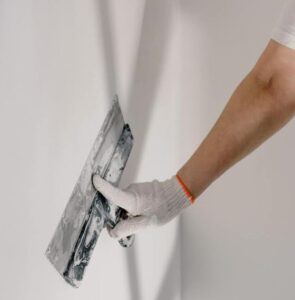DIY plaster repairs, when to call in a professional plasterer
Guest Post by William Saver
There comes a time for all homeowners when damage occurs to the interior walls of their home.
Either accidently through moving furniture or a mishap with the kids playing cricket indoors.
Dents, dings, cracks and holes in walls are all a fact of life.
Once you get over the initial shock of the damage done it’s time to solve the problem and fix the wall.
The first question that comes to mind is how difficult is it to fix?
Should I hire a professional plasterer or handyman to fix the wall, or should I try fixing it myself?
In this post we’ll discuss the types of fixes which are simple and easy enough to do DIY and what kind of jobs should be left to the pros.
What type of wall is it?
The first thing to determine is the type of material the wall is made of.
The most common building material used for interior walls in Australia is plasterboard, also commonly referred to as gyprock, gypsum board, and drywall.
We’ll focus our attention on how to repair plasterboard walls.
To DIY or not to DIY
Most minor dents, dings, cracks, and holes less than 150mm can be repaired DIY.
Although it’s important to note the main difference between DIY repairs and repairs performed by a professional plasterer, such as the guys from plasterer Toowoomba, would be the ability of the plasterer to seamlessly blend the repaired section into the rest of the wall surface with little to no indication that a repair has even taken place.
This is because plastering, like any skill takes considerable time to develop.
However, depending on the nature of the damage it’s also very possible that a DIY job will suffice.
Here are the key factors you’ll need to consider:
-
-
- Extent of the damage. Is it one tiny dent caused by a wayward hammer or is it a large gaping hole?
- Level of experience of the DIYer. Repairing dents is easy enough for any experience level, repairing large holes requires more skill in order to have a smooth seamless finish
- The location of the damage. When the damage is in an inconspicuous area the quality of the repair is not particularly important,. However when the damage is at eye level of above it’s much more likely to be noticed.
- The lighting conditions of the room where the repair is performed. Certain lighting angles can draw attention to irregularities in wall surfaces, including where a repair was performed.
- Presence of other objects which draw the attention of the eye, such as artwork, furniture, windows, etc. If you attempting to repair a large blank wall, then the repair job will be more noticeable compared to if you perform a repair in a section of wall which is adjacent to a bookshelf.
-
Careful consideration into the above factors will help you determine whether or not you should hire a plasterer to fix your damaged wall.
If you’re up for the DIY route a visit to the local hardware store and a few YouTube tutorials and you’ll be all set to tackle the task.